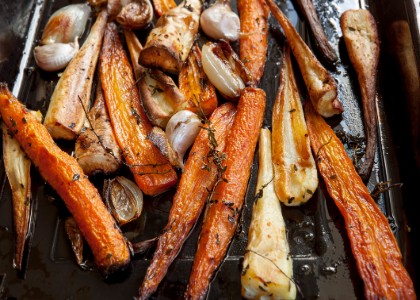
Your Guide to Root Vegetables
By Suzanne Boothby
Beets, carrots, parsnips, yams and more! Do you love root vegetables? Whether you want to roast, sauté or juice them, these vegetables are delicious and full of nutrients. They get their name because they tend to grow underground where they soak up nutrients from the soil.
These disease-fighting and energy boosting roots come with a high dose of antioxidants, vitamins, fiber and more. They also tend to be low in calories while high in slow-burning carbohydrates that help fill you up and energize you throughout the day.
Many root vegetables are available year-round, but these veggies tend to be freshest and taste the best in the fall and winter months.
With so many different types of root vegetables to try, do you know your favorite? Here’s a guide to some of the best varieties you can find at the market.
Beet
Beets will improve your health, reduce disease risk and make you look and feel fabulous. They have a unique combination of betalain pigments, as they contain both betacyanins (red-violet pigments) and betaxanthins (yellow pigments). They tend to be one of those veggies that people either love or hate, when roasted or juiced they add sweetness, but some people can’t shake that earthy flavor.
How to Prepare:
To prepare beets, simply give them a good scrub with a brush and take the top off and peel them (optional). If you don’t want pink-stained kitchen counters, be sure to chop them on a cutting board and wear gloves to avoid pink hands. It’s also great to consume the leaves, as they are a powerhouse of nutrition too. Wash the leaves and add them to salads, smoothies and juices.
Recipes to Enjoy:
Raw Beet, Banana & Raspberry Smoothie
Carrot
While these roots can get a bad rap for being higher in sugar, carrots are a powerful source of antioxidants and cancer-preventing nutrients. They do actually taste sweeter in the winter because lower temperatures encourage them to convert their starch stores into sugar, but they still contain plenty of beta carotene, fiber, vitamin K and potassium. They come in a rainbow of colors these days, and the purple varieties offer an extra boost of anti-inflammatory antioxidants called anthocyanin.
How to Prepare:
You don’t have to peel carrots, you can just give them a scrub and chop up raw. To cook, you can toss them whole in bit of coconut oil and sea salt and roast them on a baking sheet at 400 degrees for about 25 minutes.
Recipes to Enjoy:
Roasted Carrots and Avocado Salad
Parsnip
White vegetables often get overlooked when we talk about eating the rainbow and these starchy, highly underrated root veggies are full of nutrients too. They look like large white carrots, but they are slightly harder and have a deeper flavor. Parsnips are not only tasty but they’re a great source of manganese, vitamin A and C, fiber and potassium.
How to Prepare:
Wash your parsnips and they can be chopped and roasted in oil with sea salt. Set the oven at 425 degrees and cook for about 30 minutes. You can also boil parsnips and mash them with broth and butter or vegan butter.
Recipes to Enjoy:
Anti-Aging Avocado & Parsnip Salad
Sweet Potato & Yam
First things first: Is there a difference between sweet potatoes and yams? Sweet, orange-colored root vegetables that most people love are considered sweet potatoes. But sweet potatoes can vary in color from orange to white to purple. Traditionally, a yam comes from West Africa and is starchier and more potato-like, and not too sweet. But most people use the terms interchangeably. Sweet potatoes are super nutritious and contain calcium, iron, vitamin A and beta-carotene.
How to Prepare:
You can boil and mash, roast or juice a sweet potato. Boiling usually takes about 20 minutes, while roasting a sweet potato can take 45 minutes to an hour. You can also make them into noodles, known as swoodles. You can juice them raw, no need to remove the skins.
Recipes to Enjoy:
Turnip
These nutritious and humble root vegetables are part of the cruciferous family which includes cabbage, kale, and Brussels sprouts. They taste like a mix between a radish and cabbage. These small white roots are rich in vitamin C, a powerful antioxidant that can boost immunity. Turnip greens are just as important and are often forgotten, as the leaves provide many vital nutrients including vitamins A, C, K and carotenoids.
How to Prepare:
Before cooking turnips, you will have to clean them, but peeling is optional. You can easily sauté chopped turnips in a pan with butter or oil. They also roast up fairly quickly, toss them in oil and set the oven to 400 degrees for about 25-30 minutes.
Recipes to Enjoy: